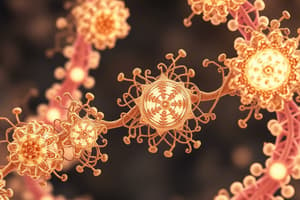Podcast
Questions and Answers
Which process generates a proton gradient across the inner mitochondrial membrane?
Which process generates a proton gradient across the inner mitochondrial membrane?
- ATP Synthase
- Electron transport chain (correct)
- Oxidative phosphorylation
- Citric acid cycle
What is the purpose of ATP Synthase in oxidative phosphorylation?
What is the purpose of ATP Synthase in oxidative phosphorylation?
- To transport protons across the inner mitochondrial membrane
- To remove electrons from NADH and FADH2
- To generate a proton gradient
- To convert ADP to ATP (correct)
Which molecules are oxidized via the electron transport chain?
Which molecules are oxidized via the electron transport chain?
- NADH and FADH2 (correct)
- Protons and electrons
- ADP and inorganic phosphate
- NAD+ and FAD
What is the role of the mitochondria in aerobic respiration?
What is the role of the mitochondria in aerobic respiration?
What is the main function of the citric acid cycle?
What is the main function of the citric acid cycle?
Which molecules are removed in the electron transport chain in the mitochondria?
Which molecules are removed in the electron transport chain in the mitochondria?
What is the process called that generates a proton gradient across the inner mitochondrial membrane?
What is the process called that generates a proton gradient across the inner mitochondrial membrane?
What is the complex that uses the proton gradient to synthesize ATP from ADP and inorganic phosphate (Pi)?
What is the complex that uses the proton gradient to synthesize ATP from ADP and inorganic phosphate (Pi)?
Which organelle is associated with all of these pathways: electron transport chain, oxidative phosphorylation, and citric acid cycle?
Which organelle is associated with all of these pathways: electron transport chain, oxidative phosphorylation, and citric acid cycle?
What molecules are generated by the citric acid cycle and then oxidized via the electron transport chain?
What molecules are generated by the citric acid cycle and then oxidized via the electron transport chain?
Flashcards
Electron transport chain
Electron transport chain
The process where electrons move through a series of proteins, ultimately producing ATP.
ATP Synthase
ATP Synthase
An enzyme that uses the proton gradient to generate ATP from ADP and inorganic phosphate.
Oxidative phosphorylation
Oxidative phosphorylation
The process of producing ATP using the energy from the electron transport chain.
Aerobic respiration
Aerobic respiration
Signup and view all the flashcards
Oxidation
Oxidation
Signup and view all the flashcards
Citric acid cycle
Citric acid cycle
Signup and view all the flashcards
Electron transport
Electron transport
Signup and view all the flashcards
Mitochondria
Mitochondria
Signup and view all the flashcards
NADH & FADH2
NADH & FADH2
Signup and view all the flashcards
Proton gradient
Proton gradient
Signup and view all the flashcards
Study Notes
Electron Transport Chain and ATP Synthesis
- The process that generates a proton gradient across the inner mitochondrial membrane is the electron transport chain.
- The purpose of ATP Synthase in oxidative phosphorylation is to use the proton gradient to synthesize ATP from ADP and inorganic phosphate (Pi).
- The electron transport chain oxidizes NADH and FADH2 molecules.
- The proton gradient generated by the electron transport chain drives the production of ATP through the process of chemiosmosis.
Mitochondria and Aerobic Respiration
- The role of the mitochondria in aerobic respiration is to generate most of the ATP through the process of oxidative phosphorylation.
- Mitochondria are the site where the electron transport chain, oxidative phosphorylation, and citric acid cycle take place.
Citric Acid Cycle
- The main function of the citric acid cycle is to produce NADH and FADH2, which are then oxidized via the electron transport chain.
- The citric acid cycle generates NADH, FADH2, ATP, and coenzyme A, which are then used in the electron transport chain.
- NADH and FADH2 molecules are removed in the electron transport chain in the mitochondria.
Studying That Suits You
Use AI to generate personalized quizzes and flashcards to suit your learning preferences.




